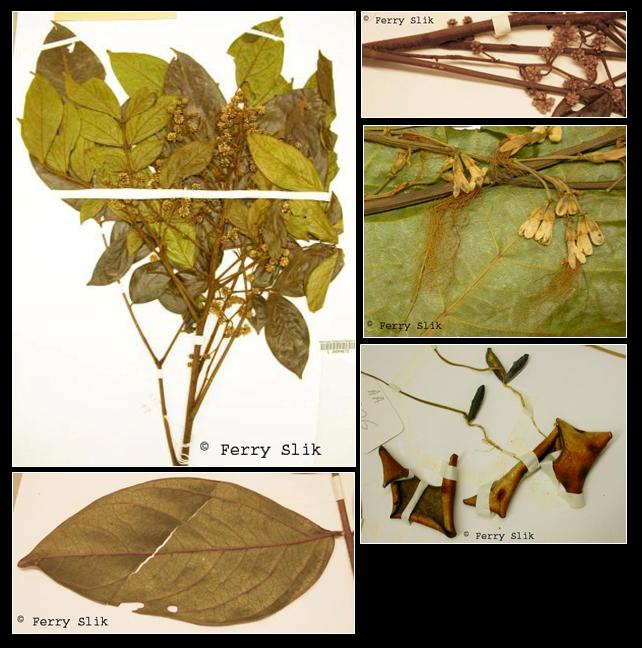Archidendron globosum (Blume) Nielsen, Adansonia ser. 2, 19, 1 (1979)
Latin for 'sphere-shaped'.Synonyms
Abarema globosa (Blume) Kosterm.
Abarema kiahii Kosterm.
Albizia rostrata Blume ex Miq.
Feuilleea rostrata (Blume ex Miq.) O.Kuntze
Feuilleea similis O.Kuntze
Inga globosa Blume
Pithecellobium affine Baker ex Benth.
Pithecellobium globosum (Blume) Kosterm.
Pithecellobium rostratum (Blume ex Miq.) Miq.
Description
Tree to 30 m high, 90 cm in diameter. Bark fawn, green, or greyish, surface
minutely fissured and cracked, or brown and smooth; slash inner bark cream or white with
somewhat disagreeable turnip smell; sapwood white; heartwood dark yellow, soft.
Branchlets terete, red-brown, shortly rusty tomentose in
the distal parts, often with glandular hairs, glabrescent. Leaves: rachis 6-20.5 cm, scarcely puberulous
by patent hairs or shortly tomentose, glands raised, sessile, circular or semiglobose, 1.5-3
mm in diameter; pinnae 1-3 (or 4) pairs, 5-20 cm, scarcely puberulous with patent hairs or shortly
tomentose; petiolules 1-4 mm, (patently) puberulous; leaflets (3 or) 4-7 pairs per pinna, opposite,
chartaceous, drying dark brown /dark green above and light brown/light green beneath, usually
unequal-sided, obovate, elliptic, subtrapezoid, or lanceolate-oblanceolate, 5-17.5 by 1.5-7 cm,
base cuneate to asymmetrically half cuneate/half truncate, apex acuminate-caudate, upper surface
glabrous with puberulous veins, lower surface glabrous or puberulous, often with reddish glands,
midvein usually densely puberulous or hirsute; principal lateral veins 6 or 7 per leaflet-half, non
parallel, strongly arching, the lower ones running into the distal half of the leaflet; reticulation dense,
prominulous above, prominent beneath Inflorescences terminal or axillary in the distal leaf-axils,
rusty tomentose and with glandular hairs, consisting of pedunculate glomerules aggregated into panicles,
c. 40 by 40 cm; glomerules consisting of 25-30 sessile flowers; floral bracts spathulate,
c. 1 mm, sericeous. Flowers pentamerous, bisexual. Calyx tubular or narrowly funnel-shaped, 3.5-5
mm, densely sericeous and with glandular hairs; teeth triangular, acute, 0.5 mm. Corolla narrowly
campanulate, (6-)8-l 1 mm, densely sericeous and with glandular hairs; lobes triangular-ovate, acute,
2-3 mm. Stamens white, c. 15 mm, tube shorter than the corolla-tube. Ovary solitary, glabrous. Pods
reddish-orange both outside and within, curved into a semi- to full circle, 6-7 cm in diameter, valves
2-3 cm wide, slightly sinuate, coriaceous, glabrous, with a few prominulous veins, dehiscing
first along the ventral suture. Seeds bluish-black, ellipsoid, c. compressed, c. 25 by 10-15 mm.
[from Flora Malesiana]
Ecology
Dense lowland and hilly rain forest, lower montane forest; Along rivers on sandy soils; altitude 0-1000 m.
Uses
The acid fruit used in curries and chumies; the roots used for poulticing boils; wood not commercial,
but used locally for beams.
Distribution
Burma, Indo-China, Peninsular Malaysia, Sumatra, Java, Lesser Sunda Islands,
Borneo.
